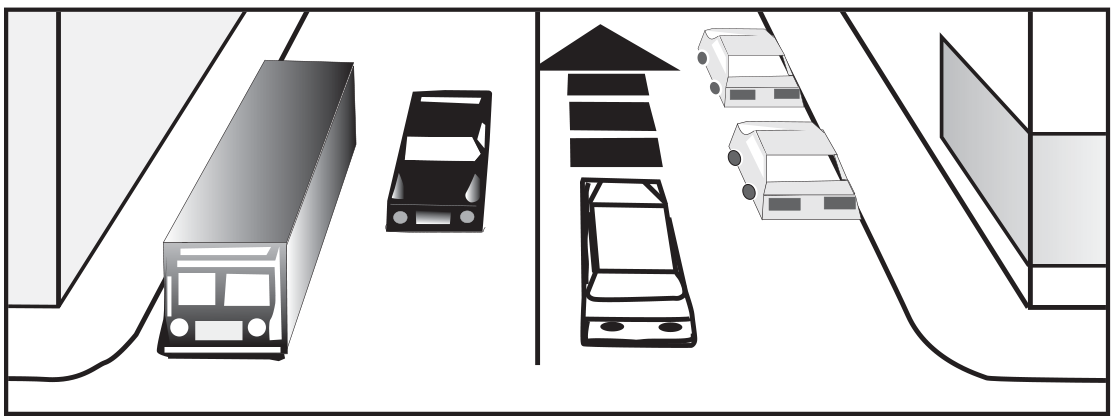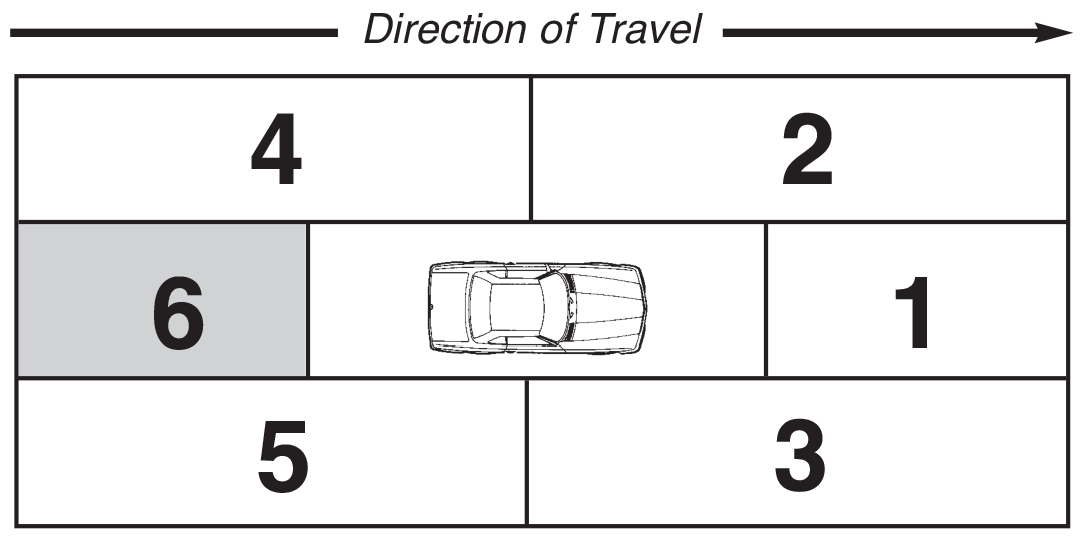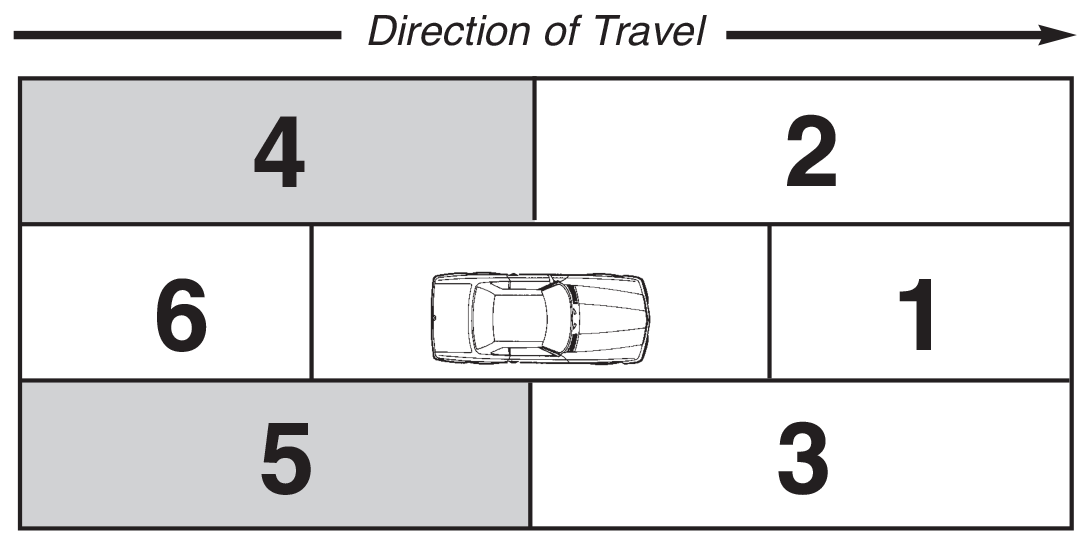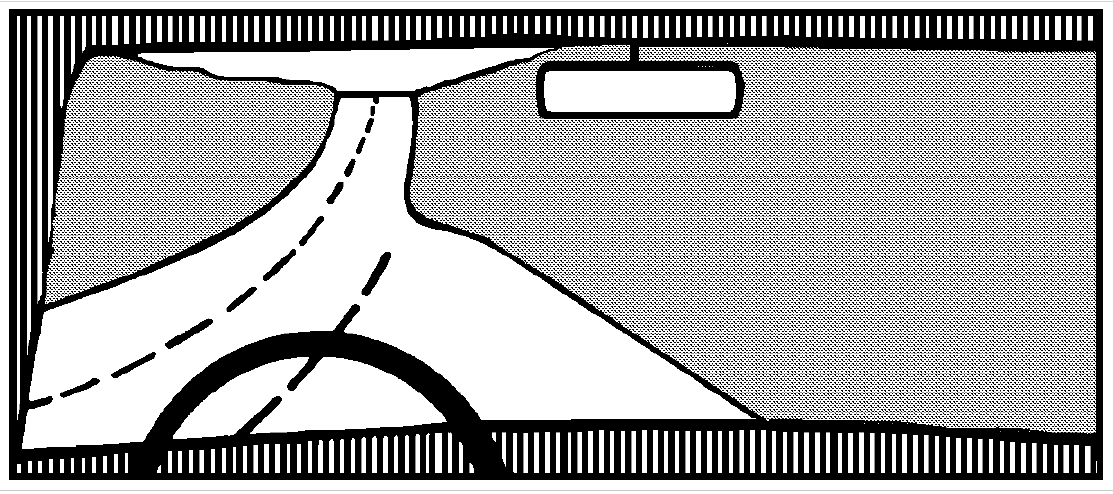Managing Space
If another driver near you makes a mistake, you will need time to react to the situation. The only way to be sure you will have enough time to react is to leave plenty of space between you and the vehicles around you.
As shown in the diagram below, there are six areas of space around your vehicle you must be able to manage.
It is best to keep a space cushion on all sides of your vehicle.
Keep A Space Cushion Ahead (4-Second Rule)
What is a safe following distance? A 4-second following distance, as shown above in Area 1 of the space-management diagram, will allow you to steer or brake to avoid a hazard safely on the highway, if the pavement is dry.
- If you are following too closely and the vehicle ahead of you stops or slows suddenly, you will not be able to avoid a crash.
- Keeping a safe following distance will enable you to react to a problem ahead without the need for a panic stop, which could cause a following driver to crash into the back of your vehicle.
- To determine your following distance, watch the rear bumper of the vehicle ahead of you. When the bumper passes a road marking or a roadside object like a telephone pole, start counting how many seconds it takes you to reach the same spot on the road. If you pass the marking or object in less than four seconds, you are following too closely.
Sometimes you will need extra space ahead of you. Allow a longer following distance than usual when:
- Traveling on roads that are wet and slippery, or not paved. There is less traction, so it takes longer to stop.
- The driver behind you wants to pass. There must be room ahead of you for the passing driver to pull in front of you.
- You are following a driver whose rear view is blocked. Drivers of trucks, buses, vans, or cars pulling campers or trailers may slow down suddenly without knowing you are behind them.
- You are following a large vehicle blocking your view ahead. You need extra room to see around the vehicle.
- You are following a driver who is carrying a heavy load or pulling a trailer. The extra weight will make it more difficult to stop.
- Approaching slow-moving vehicles, including bicycles.
- You are following school buses, taxis, public and private buses, and trucks transporting hazardous substances. These vehicles must stop at railroad crossings and make other, unexpected stops.
- You are driving downhill. It is harder for your brakes to slow your vehicle, especially at high speeds.
- You are stopped on an uphill. The vehicle ahead may roll back into your vehicle when traffic begins to move.
Keep A Space Cushion To The Sides
A space cushion to the sides, as shown in Areas 2 and 3 of the space management diagram, will give you room to react, if another vehicle suddenly moves into your lane. These areas are your potential escape paths.
Key points to remember are:
- Avoid driving alongside other vehicles on multi-lane streets. They block your view and close your escape route, and you are probably in their blind spot.
- Keep as much space as possible to the side of your vehicle and oncoming vehicles.
- Make room for vehicles entering highways by signaling and moving to an inside lane, if it is safe.
- Keep space between your vehicle and parked vehicles. Someone may open a vehicle door or step out between parked vehicles, or a vehicle may pull out suddenly.
- If you do not have at least 8 feet of space on at least one side of your vehicle to use as an escape path, you will need to allow more space to the front by increasing your following distance.

You will usually drive in the center of your lane. But sometimes, you will find dangers on both sides of the road. As in the example pictured to the right, there may be parked vehicles to your right and oncoming vehicles to your left. In this case, the best thing to do is to slow down and "split the difference" by steering a middle course between the oncoming vehicles and the parked vehicles.
Keep A Space Cushion Behind

In Area 6 in the space management diagram, a driver who is following you has more control over the clear space than you do, but you can help by keeping a steady speed and signaling before you have to slow down for a turn. If you see someone following you too closely (tailgating), move over to the right lane, if possible. If there is no right lane, you can encourage the tailgater to move around you by waiting until the road ahead is clear, then tapping your brakes gently to slowly reduce your speed. Also, look for an escape path to the side when you are preparing to slow down or stop.

Finally, pay attention to what is happening in the left-rear and right-rear areas behind you (Areas 4 and 5 of the space management diagram). You need to know how close other vehicles are to your vehicle and how fast they are traveling. These areas are blind spots, always check them by turning your head before changing lanes.
Keep Your Vehicle Where It Can Be Seen
Avoid driving your vehicle in another driver's blind spot. A blind spot is any place around a vehicle a driver cannot see without moving their head. Here are some good rules to help you avoid this mistake:
- Avoid driving on either side and slightly to the rear of another vehicle for a long time. Both positions are blind spots for the other driver. Either speed up or drop back to move out of the driver's blind spot.
- When passing another vehicle, get past the other driver's blind spot as quickly and as safely as you can. The longer you stay in the blind spot, the longer you both are in danger.
Looking Ahead

The driver in the picture is in a lane that ends soon. If this driver does not change lanes, the driver may have to make a quick lane change or stop and wait for traffic to clear.
To avoid last-minute moves, you must look far enough ahead to see and react to things early. You should be able to identify problem situations 12 to 15 seconds ahead — about one block in the city, or a quarter of a mile at highway speeds.
Your ability to handle dangerous traffic situations depends largely on searching for and identifying problems far ahead. Looking far ahead does not mean you should simply stare at the center of the road. You need to continually scan the entire road, including the sides of the road.
As you scan the driving scene, watch for:
- Vehicles and people who enter the road ahead of you and may be moving much slower.
- A vehicle that has slowed or stopped ahead, waiting for other traffic to clear before making a turn.
- Signs warning of danger ahead.
- Signs telling you about places ahead and/or giving you information about how to reach them.
Looking To The Sides
Looking to the sides is especially important at intersections, driveways, shopping center entrances and exits, and highway entrances and exits — any place where one stream of traffic meets another. When you come to an intersection, follow the "left-right-left" rule:
- Look to the left first, because vehicles coming from the left are closer to you.
- Look to the right.
- Look again to the left before you pull out. You may see a vehicle you did not see the first time you looked.
When you enter the intersection, look left and right again. Do not assume other traffic will always stop, even when there is a stop sign or signal. If your view of the cross street is blocked by buildings, shrubs or parked vehicles, move forward slowly until you can see clearly
Looking Behind
You must also check traffic behind you as often as possible. This is very important when you are planning to change lanes or back up.
Changing lanes includes:
- Changing from one lane to another on a roadway.
- Entering a highway from an entrance lane.
- Entering the roadway from the curb or shoulder.
Before you change lanes, give the proper turn signal. Look in your rearview and side mirrors and make sure no one is going to pass you. Do not depend on mirrors or sensors alone, look over your left and right shoulders to make sure no one is in your vehicle's blind spots. Check these spots quickly. Do not take your eyes off of the road ahead for more than a second. On roads with three or more lanes, check all lanes before you make a lane change — someone in another lane may also be planning to move into the same spot where you want to go.
Backing Up
When backing up, always check behind your vehicle — do it before you get in your vehicle. Children or small objects are hard to see from the driver's seat. Before backing up, turn your head so you can see through the rear window. Do not depend on your mirrors or sensors alone.